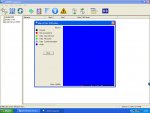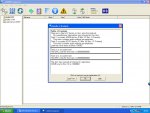Have you been able to replicate the pop-up?
Trying to think what could be placed in a single session... (and doing a "show CD properties" from most writer programs should confirm that it is single session).
1. Fields such as the Title, Artist etc. - it's possible that Soundforge may place something here, but it's not a file, and I know of no simple means of triggering it to be displayed.
2. "Don't play track 1" - if it has a track 1 that will not play as audio, or is just noise if it does, then it's a "Mixed mode" data plus audio.
3. Data in pregap - I don't know how to produce these, but this involved a longer than normal pregap, containing data - on some audio CD's, this is used for a hidden audio track that can only be backspaced into.
4. CD-Text (in TOC subchannels) or CD-G (in track subchannels)
Without grossly violating specifications, and with no standard method of retrieval, I cannot see what else could exist in single session.
A mono tape played through a stereo transfer, may have experienced slight channel skew, this may give rise to a diversity effect.
The questions are many:
Are you suspecting malicious interference with the transfer, or merely misguided attampts to clean it up.
Are you considering that it may have included tampering with the master tapes, or is the issue the authenticity of those tapes in the first place.
Some recorders do put RIN codes on as an anti-piracy measure (traceable to that recorder), bur again, I have absolutely no idea what would be capable of displaying them.


